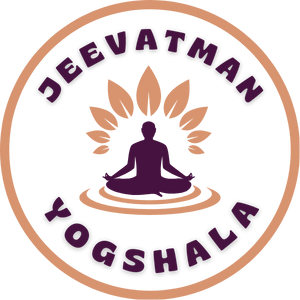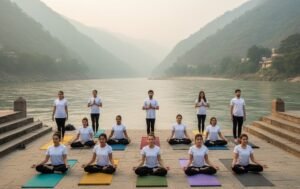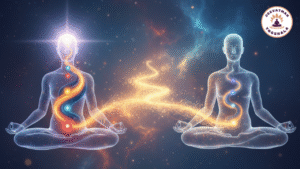Head-to-Knee Pose, or Janu Shirshasana, is a seated forward bend that has strong therapeutic effects on the body and the mind. This pose is popular in Hatha and Vinyasa yoga and provides deep stretching for the hamstrings, hips, and spine, as well as being beneficial for a sense of calm and introspection.
Yoga poses are not merely physical, they also have profound meanings. Janu Shirshasana epitomizes some of the most important yogic philosophies:
Philosophical Significance
- Humility and Release: Folding to head to knee demonstrates humbleness and letting go. It represents pride, relinquishing control, and the acceptance of the current moment.
- Humility and Release: Folding to head to knee demonstrates humbleness and letting go. It represents pride, relinquishing control, and the acceptance of the current moment.
- Introspection: The pose looks inward. It turns into a time of silence and meditation, allowing us to connect with our mind, heart and soul.
- Counter theyogapilatesplace.comOpposite: One leg is bent, the other straight. It’s about balance — between strength and flexibility, tension and surrender, power and ease — much like the realities of life.
- Patience and Progress: It takes time for this pose to go deep. It is a gentle reminder to Take The Time, Trust The Process, and Honor Our Current Limitations without judgement.
How to Perform Janu Shirshasana (Head-to-Knee Pose)
- Sit with your legs straight ahead.
- Bend your right knee, and put the sole of your right foot to the inner left thigh.
- Point your left toes and flex that foot, and keep the leg active and grounded.
- Sit upright with a flat back, stack your body directly over the left leg.
- Inhale, and as you exhale, gently fold forward from the hip — not the low back.
- Lead with your chest, maintaining length in your spine as you fold forward.
- Reach your hands forward toward your left foot, ankle, or shin.
- Allow your head to hang toward your knee, but don’t coax or push it.
- Keep both hips grounded. If necessary, use a folded blanket or cushion beneath your bent knee or hip.
- Stay in the pose for 30 seconds to 1 minute, breathing slowly and steadily.
- Inhale and rise back up to the starting position.
- Switch sides and do a lunge on the left leg.
Warm Up Poses Prior to Janu Shirshasana
Warming up to this pose helps the body fold with more comfort and safety. Here are some poses to prepare you for this pose:
- Baddha Konasana (Bound Angle or Butterfly Pose): Promotes hip and inner-thigh opening.
- Supta Padangusthasana (Reclining Hand-to-Big-Toe Pose): Hamstring stretch while on your back, and a safer way of extending.
- Uttanasana (Standing Forward Fold): Softens the hamstrings and spine, replicating the fold of Janu Shirshasana.
- Ardha Hanumanasana (Half Splits Pose): A deep stretch of the hamstrings, and a good teacher of stability in forward bending.
These poses help to open your hips, hamstrings, and spine and get you in the right frame of mind.
Benefits of Janu Shirshasana
There are so many benefits of Janu Shirshasana. Here are the main physical, mental and emotional benefits:
Physical Benefits
- Lengthens Hamstrings: To alleviate tightness in the hamstrings and increase range of motion.
- Specific Hips and Groin:Stretches the inner thighs and hip flexors as well as opens up the hips.
- Spinal stretch: Sitting in a forward fold relieves tension in the back and is good for your spine.
- Improves Digestion: Engage in a little healthy ab compression to help improve digestion and keep everything flowing properly in that area.
Mental and Emotional Benefits
- Nervous System Soother: Promotes calming and helps to reduce anxiety or mental chatter.
- Sharper Focus: The lack of motion in the pose increases awareness and mindfulness.
- Promotes Patience: As the stretch develops over time, it teaches patience and acceptance.
- Promotes Self-Awareness: Aids in the connection between the body and breath.
- Energetic rejuvenation: Energizes the body by stimulating flow of prana (energy) through the body and refreshes it with the lightness of being.
Precautions and Safety Precautions for Janu Shirshasana
While it is generally safe, some individuals should take caution or rework the pose to accommodate their body’s condition.
Avoid Forcing the Pose
Never force yourself into a deep stretch. It can because strain in your hamstrings, hips or lower back. Only go as far as your body feels comfortable doing so.
Knee or Hip Injuries
If you are injured in the knee or hip, prop your bent leg with a blanket or bolster. Do not let the knee swing out excessively. A yoga instructor can help you adjust safely.
Lower Back Conditions
If you have herniated disc(s) or sciatica, then maintain a nice long spine and do not round your lower back. Use a cushion or props if necessary. In some cases, you should not even attempt this pose unless you are in a professional setting.
Pregnancy Considerations
Pregnant women — and especially women in the second and third trimesters — should steer clear of deep forward bends like this one. Spare, supported or alternative poses are the way to go with this gentle variety. See a prenatal yoga expert before attempting.
Enhance your practice with Jeevatman Yogshala
Deeper understanding of postures like Janu Shirshasana isn’t going to happen by simply practicing them, it’s got to come with proper guidance and traditional learning.
At Jeevatman Yogshala in Rishikesh, our Yoga Teacher Training Courses (TTC) are designed to give you in-depth knowledge and hands-on experience in such asanas. Under the supervision of skilled yoga masters, you’ll explore physical alignment, breathing techniques, adjustments, and the mental side of the practice.
If you’re looking to become a certified yoga teacher or want to deepen your personal practice, join our upcoming TTC batch. Experience authentic yoga in the birthplace of yoga itself—Rishikesh, India.
Conclusion
Janu Shirshasana is more than a stretch—it’s a practice of awareness, humility, and surrender. It helps improve flexibility, calm the mind, and connect deeper with yourself. With proper preparation, patience, and mindfulness, this pose can become a valuable part of your daily yoga practice.
Ready to explore more? Let Jeevatman Yogshala guide you on this path. Discover the power of yoga not just as exercise, but as a way of life.








